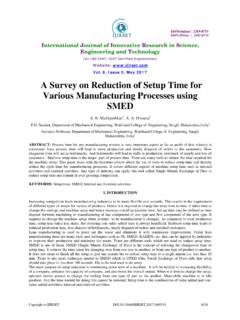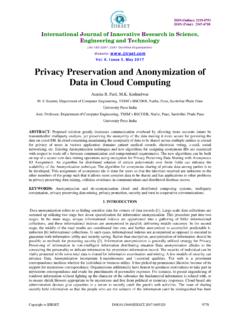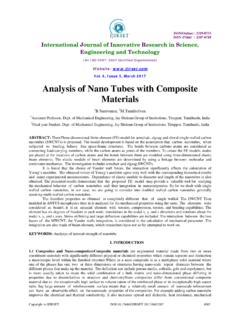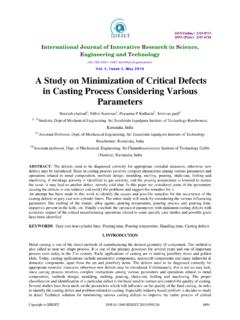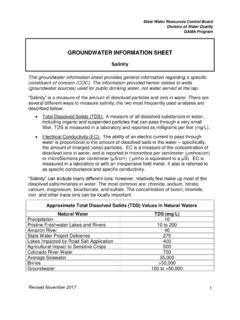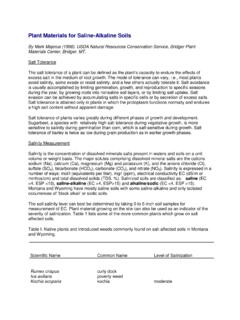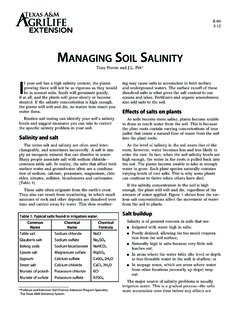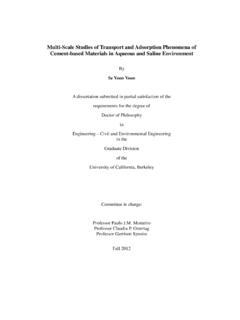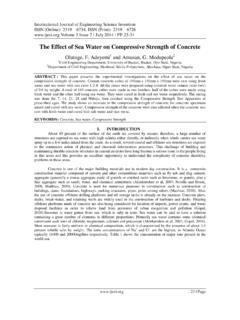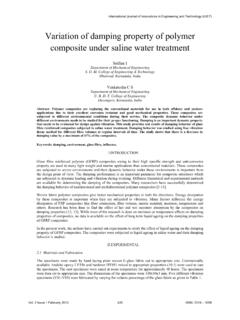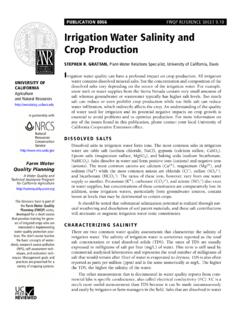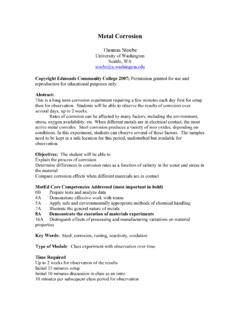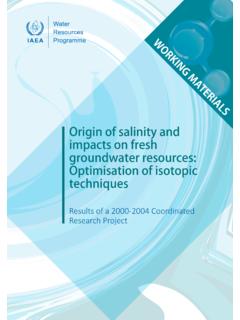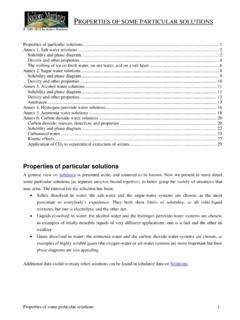Transcription of Effect of Saline Water on Geotechnical Properties of Soil
1 ISSN(Online) : 2319-8753 ISSN (Print) : 2347-6710 International Journal of Innovative Research in Science, Engineering and Technology (An ISO 3297: 2007 Certified Organization) Vol. 5, Issue 9, September 2016 Copyright to IJIRSET 16181 Effect of Saline Water on Geotechnical Properties of Soil Yogesh Pathak1, Ashutosh Pathak2 Assistant Professor, Department of Civil Engineering, Rajkiya Engineering College, Bijnor, , India1 Assistant Professor, Department of Civil Engineering, Rajkiya Engineering College, Ambedkar Nagar, , India2 ABSTRACT: In this research, the Effect of Water salinity on Geotechnical Properties of fine grained soilcollected from Sultanpur & Ambedkar Nagar was studied.
2 In the Laboratory, Several tests such as Atterberg limit test were done withdistilled Water and Water of different concentration of Nacl. Results on soil show that both liquid limit and plastic limit decreases with increase in salinity. Increase in salinity increases optimum moisture content and decreases maximum dry density. KEYWORDS: Atterberg Limit, Nacl , Standard Protor Test , Optimum Moisture Content , Maximum Dry Density. I. INTRODUCTION The chemistry of Pore Liquid effects the Geotechnical Properties of soil. From sea Water intrusion or from the leachate coming out from rocks containing several minerals, Saline Water enters into in-situ soil. For the proper understanding of the behaviour of soil when reacted with Saline Water ,it must be mixed in proper concentration and their Effect on the Geotechnical Properties of soil must be studied.
3 II. RELATED WORK In the current study soil from Ambedkar Nagar&Sultanpur was used to study how Geotechnical Properties of soil is affected by Salinity. The salinity of sea Water is about 0:1M NaCl to Nacl solution. Therefore, NaCl solutions of varying concentrations were used in order to simulate higher and lower salinity levels in soil. Atterberg limits are one of the tests that are done on soil. Atterberg limits can be useful indicators of clay behaviour. The liquid limit and plastic limits of a type of soil can be correlated with various engineering Properties , such as permeability, shrinking and swelling behaviour, shear strength, and compressibility of the soil. Consequently if the consistency limits are determined, some other Geotechnical Properties whose determination may take a long time can be estimated easily with acceptable accuracy.
4 Another test performed on soil is compaction test. Soil compaction improves strength characteristics of soil and consequently increases bearing capacity of foundations constructed on Compaction test was originally developed to mimic field compaction in the lab. The aim of the test was to find the optimum moisture content at which the maximum dry unit weight is attained. OF SALINATION ON DIFFERENT FIELDS As a result of rising Water tables in irrigated and non-irrigated areas or the use of Saline Water supplies salinity can have significant impacts on the following aspects. Water moves into plant roots by a process known as osmosis, which is controlled by the level of salts in the soil Water and in the Water contained in the plant. If the level of salts in the soil Water is too high, Water may flow from the plant roots back into the soil.
5 This results in dehydration of the plant, causing yield decline or even death of the plant. Crop yield losses may occur even though the effects of salinity may not be obvious. The salt tolerance of a specific crop depends on its ability to extract Water from salinized ISSN(Online) : 2319-8753 ISSN (Print) : 2347-6710 International Journal of Innovative Research in Science, Engineering and Technology (An ISO 3297: 2007 Certified Organization) Vol. 5, Issue 9, September 2016 Copyright to IJIRSET 16182 soils.
6 Salinity affects production in crops, pastures and trees by interfering with nitrogen uptake, reducing growth and stopping plant reproduction. Some ions (particularly chloride) are toxic to plants and as the concentration of these ions increases, the plant is poisoned and dies. The most significant off-site impact of dryland salinity is the salinization of previously fresh rivers. This affects the quality of Water for drinking and irrigation with serious economic, social and environmental consequences for both rural and urban communities. High levels of salts may affect the taste of drinking Water . Chloride in particular has a low taste threshold. Sodium and magnesium sulphate levels in drinking Water may produce a laxative Effect and reduce the suitability of a Water supply for grazing animals. Salt interacts with in-stream biota (animals and plants), changing the ecological health of streams and estuaries.
7 The greatest threat to biodiversity is from the loss of habitat both on land and in Water . Riparian zones are particularly at risk as they occupy the lowest parts of the landscape where much of the Saline groundwater is released to the surface. Salts also help fine materials (such as suspended clay particles) to flocculate, allowing more sunlight to penetrate rivers. This may lead to more harmful algal blooms if there are suitable environmental conditions. Much of the natural vegetation of salt-affected areas has been destroyed or damaged. This has caused major changes to the landscape and biodiversity including the destruction of remaining natural habitat in many agricultural areas and the fragmentation of many wildlife corridors. Dryland salinity is closely linked to other soil degradation issues, including soil erosion.
8 Salinity is often associated with prolonged wetness and lack of surface cover and therefore increases the vulnerability of soils to erosion. Shallow Water tables can increase the risk of flooding. Soils in this situation have limited capacity to absorb rainfall, resulting in high rates of run-off. This can result in damage to roads, fences, dams, agricultural land and wetlands. Impacts include large decreases in the lifespan of road pavements when groundwater levels rise to within 2 metres of the pavement surface. As in other situations, capillary action will assist to draw the salt-laden Water to the surface. Salt also corrodes and destroys the Properties of bitumen, concrete and brick structures. Damage to infrastructure including houses, roads and playing fields, has been particularly high in a number of cities and towns.
9 Salinity damage has also occurred to country roads and farm tracks and buildings. All irrigation Water contains some salts, which may remain on the soil surface or on leaves of plants after evaporation. Therefore, any irrigation system has the potential to deliver an increased amount of salt to the soil. To study the Effect of salt Water on the behavioural parameters of fine-grained soil, the basic characteristics of the soil and Water samples were measured. Then laboratory tests including Atterberg limits, standard compaction were done with all three types of Water according to procedures referred to in this section. IV. METHODOLOGY In the current study two different soils were used. The liquid limit and plastic tests were conducted by following IS code. Procedure for determination of liquid limit and plastic limit Clay Water mixtures of both soils were prepared by thoroughly mixing clay powders with distilled Water and NaCl solutions.
10 Clay- Water mixtures were kept in sealed plastic container for 24 hours in order to allow clay- Water mixture to equilibrate properly. After 24 hours clay- Water mixtures were remixed and used for determining liquid limit by Casargrande apparatus. Both soils were mixed with distilled Water as well as 0:1M, 0:5M and 1:0M NaCl solutions. Liquid limit tests were conducted using Casargrande apparatus. Plastic limit tests were carried by rolling the soil- Water mixture in between palms until the thickness of thread become 3mm and it starts to crumble on the surface. The Water content at that point was measured. Proctor compaction test Clay Water mixtures with different Water contents were mixed with both soils, Standard Proctor test was performed to find out Optimum moisture content and Maximum dry density with distilled Water and with 0:1M,0:5M and 1M Nacl solution.
